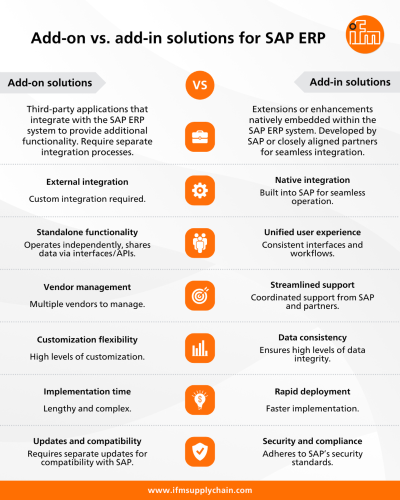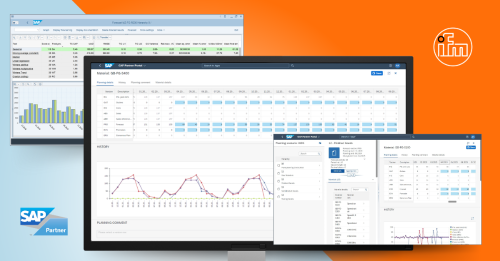Understanding the Difference: Add-On vs. Add-In Solutions for SAP ERP
Optimizing an SAP ERP system is essential for many businesses aiming to enhance operations. A crucial decision in this process is choosing between add-on and add-in solutions. While these terms might seem interchangeable, understanding the distinctions between them is key to effective implementation and operational success. Let's break down what sets them apart and why it matters for your business.

Infographic comparing add-on vs. add-in solutions for SAP ERP
What are add-on solutions?
Add-on solutions are third-party applications designed to extend the capabilities of your SAP ERP system. These solutions are developed externally and require a separate process to integrate with SAP. Think of add-ons as auxiliary tools that work alongside your main system but aren’t embedded within it. While these solutions can offer powerful, specialized features, they often come with operational complexities.
Key characteristics of add-on solutions:
- External integration: Custom processes are needed to integrate add-ons, often making them time-consuming.
- Standalone functionality: Operates independently and shares data with SAP via APIs or interfaces.
- Vendor management: Managing multiple vendors for support, updates, and licensing.
- Customization flexibility: Offers significant customization for niche needs.
- Implementation time: Typically longer due to complex integration.
- Updates and compatibility: SAP updates may require adjustments to keep the add-on compatible.
Drawbacks of add-on solutions:
One major drawback of add-ons is that they often require employees to export data out of the SAP system to analyze, visualize, and make decisions. Afterward, this data may need to be re-imported into SAP, creating a disjointed workflow. This process is not just time-consuming; it also opens the door to several risks:
- Time and productivity loss: Manually moving data between systems takes valuable time and can reduce productivity.
- Error risks: Exporting and re-importing data increases the likelihood of errors, which can impact decision-making and data accuracy.
- Stale or bad data: By the time data is re-imported, it may already be outdated, leading to decisions based on stale or inaccurate information.
These challenges can make add-ons less appealing for companies looking for seamless, real-time data management within SAP.
What are add-in solutions?
Add-in solutions are natively embedded extensions that integrate directly with your SAP ERP system. Unlike add-ons, these solutions are developed by SAP or aligned partners and work seamlessly within the SAP framework. This native integration offers a more cohesive experience with fewer complications.
Key characteristics of add-in solutions:
- Native integration: Directly embedded in SAP, ensuring smooth operation.
- Unified user experience: Utilizes the same interface and workflows as SAP, reducing training time.
- Streamlined support: Coordinated support from SAP and its partners.
- Rapid deployment: Faster implementation due to natural compatibility.
- Data consistency: Minimal data discrepancies, ensuring real-time data accuracy.
- Security and compliance: Adheres to SAP’s high security standards.
Benefits of add-in solutions:
- Seamless integration: Works directly within SAP, eliminating the need for external data transfers.
- Consistent experience: The familiar interface streamlines usage.
- Simplified maintenance: Easier updates and maintenance.
- Enhanced data accuracy: Reduces the risks of stale or outdated data.
Why distinguishing an extension from a third-party application matters
It’s essential to understand the fundamental difference between extensions and third-party applications when enhancing your SAP ERP. Add-ons are external tools that may offer specialized features but often require data to be moved in and out of SAP for analysis. This can disrupt workflows and lead to potential data errors. In contrast, add-ins are embedded solutions that extend SAP capabilities without needing complex data exports or imports. They maintain data integrity, save time, and provide real-time access, allowing employees to make informed decisions more efficiently.
Making the right choice
The decision between add-on and add-in solutions depends on your business needs, infrastructure, and long-term strategy. Add-ons can be appealing for their specialized features and customization, but they come with potential productivity losses and data integrity risks. Add-ins offer seamless integration, consistent user experiences, and real-time data management, making them ideal for businesses seeking efficiency and simplicity.
Understanding whether an extension is an add-in or an external add-on can help you enhance your SAP ERP effectively. Weighing the benefits and drawbacks of each will guide you toward the solution that best supports your operations and growth. For tailored advice on optimizing your SAP ERP, feel free to reach out to us today.


